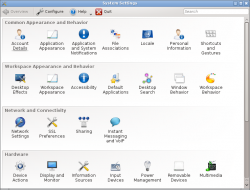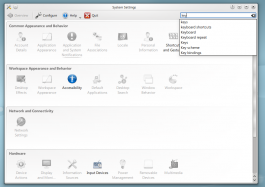System Settings/es: Difference between revisions
update translation, spanish |
update translation, spanish |
||
| Line 63: | Line 63: | ||
En la esquina inferior izquierda de la pantalla hay un botón <menuchoice>Settings</menuchoice>. Asegúrate de que la casilla <menuchoice>Gestures</menuchoice> está activada. Establece el tiempo de espera que mejor te parezca. Tu botón derecho del ratón puede ser diferente, yo he elegido 3 para usar el botón derecho del ratón. Si quieres que los gestos de ratón se activen automáticamente, activa la casilla "Start the input Actions daemon on login". | En la esquina inferior izquierda de la pantalla hay un botón <menuchoice>Settings</menuchoice>. Asegúrate de que la casilla <menuchoice>Gestures</menuchoice> está activada. Establece el tiempo de espera que mejor te parezca. Tu botón derecho del ratón puede ser diferente, yo he elegido 3 para usar el botón derecho del ratón. Si quieres que los gestos de ratón se activen automáticamente, activa la casilla "Start the input Actions daemon on login". | ||
=== | ===Crear un grupo de acciones de gestos de ratón=== | ||
Right click on the left pane (in an empty area under the list of action groups) and choose <menuchoice>New Group</menuchoice>, rename that group to "Mouse Gestures" and check the checkbox attached to its name. | Right click on the left pane (in an empty area under the list of action groups) and choose <menuchoice>New Group</menuchoice>, rename that group to "Mouse Gestures" and check the checkbox attached to its name. | ||
Revision as of 23:31, 17 September 2010
Template:I18n/Language Navigation Bar
Características
- Centro de control de la configuración global de la plataforma KDE.
- Personaliza y administra tu escritorio desde un solo lugar.
- La función de busqueda reduce el numero de probables configuraciones
Buscar
System Settings proporciona una función de búsqueda para encontrar una configuración en concreto. Simplemente escribe una palabra clave en el campo de búsqueda de la barra de herramientas y System Settings mostrará los módulos que contienen dicha palabra y ocultará los que no. Los módulos de System Settings también son accesibles a través de KRunner.
Categorías
Common Appearance and Behavior
Detalles de la cuenta

Configura la información de tu usuario, la contraseña y las rutas. También puedes configurar tus proveedores de escritorio social. Apariencia de las aplicaciónes

Configura el estilo de tus aplicaciones, colores, iconos, tipos de letra y emoticonos.
Hardware
Dispositivos de entrada

Configura tu teclado, el ratón y el joystick.
Administración del sistema
Pantalla de inicio de sesión

Configura el gestor de inicio de sesión (KDM). Arranque y apagado

Configura el comportamiento de tu sistema al arrancar y al apagar.
Gestos de ratón
- versión 4.4.4 de KDE SC
El lugar por donde empezar es ""
Activar los gestos de ratón
En la esquina inferior izquierda de la pantalla hay un botón . Asegúrate de que la casilla está activada. Establece el tiempo de espera que mejor te parezca. Tu botón derecho del ratón puede ser diferente, yo he elegido 3 para usar el botón derecho del ratón. Si quieres que los gestos de ratón se activen automáticamente, activa la casilla "Start the input Actions daemon on login".
Crear un grupo de acciones de gestos de ratón
Right click on the left pane (in an empty area under the list of action groups) and choose , rename that group to "Mouse Gestures" and check the checkbox attached to its name.
Creating a new mouse gesture
From now on I will assume that the new group is called "Mouse Gestures". Right click on and choose (here there are three options but I didn't manage to work with "Send Keyboard Input") using "Command/URL" or "D-Bus Command" you will need to create a gesture and bind an action to it.
To create the gesture
Click on your and select the tab. in the bottom of the screen there is an button (click it). In the box that just opened draw your gesture using the left mouse button.
To bind an action
if you chose simply enter that command/url under the tab at the field.
Examples using Command/URL
Close window
This command will let you close the next window you mouse click on. Note: wmctrl may not support your Window Manager.
Command/URL: wmctrl -c :SELECT:
to close the active window
Command/URL: wmctrl -c :ACTIVE:
Examples using D-Bus
If you chose D-Bus, here are few examples.
Finding out what to fill where, is done with the help of the "Launch D-Bus Browser", using that browser you can find what method you wish to call in what application object. Using D-Bus we need to fill some fields, the field name will be regular and the content italic.
Runner
This will display the Runner dialog.
Remote Application: org.kde.krunner
Remote Object: /App
Function: org.kde.krunner.App.display
Audacious next/previous/pause/play/stop/repeat track
Remote Application: org.mpris.audacious
Remote Object: /Player
Function: org.freedesktop.MediaPlayer.Next (replace Next with Prev/Pause/Stop/Play/Repeat)
Audacious PlayPause track
If not playing will play, if playing will pause.
Remote Application: org.mpris.audacious
Remote Object: /org/atheme/audacious
Function: org.atheme.audacious.PlayPause
display the actions pop-up. (I am using that to search and translate words)
Remote Application: org.kde.klipper
Remote Object: /klipper
Function: org.kde.klipper.klipper.showKlipperManuallyInvokeActionMenu


